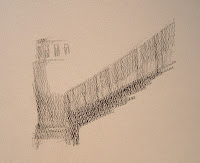

These two prints were made with the zinc plate etching method. Aquatint, an acid resistant etching ground is melted on the zinc plate. (There is also a brushable version available) Then using dry point tools, the artist begins to draw into the ground, exposing the metal. The plate is immersed into an acid bath that will react with the exposed zinc and eat away at it leaving a cavity behind that can accept ink. Immersion lasts anywere from 30 seconds to 2 minutes, depending on how dark of a line the artist wants. The process is repeated for hatching or for tinting. To tint areas the artist uses the mezzotint method, sprinkling a powder (or using spray paint) over an area which will leave behing hundreds of little pockets or dots that after an acid bath make an area tinted. After the plate is cleaned off, etching ink is applied and rubbed in, wiping away all excess with paper from a yellow pages. The paper is prepared by soaking it in lukewarm water. Different types of paper require different soaking times. The plate is placed face up on the press with the paper over it and then passed through (electric presses are easier to use than hand presses and have a consistant result). The ink is tranfered to the paper and viola your etching has been printed! A zinc plate can probbably produce 100-150 prints before warping. Copper plates will last much longer, up to 300 prints.




























